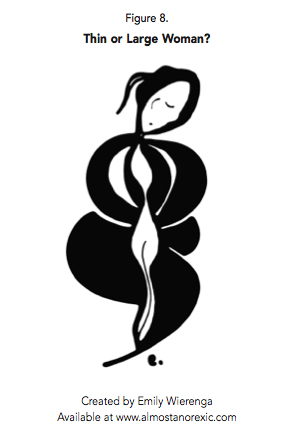
During National Eating Disorders Awareness Week, I was reminded just how much our society encourages us to wear “Ed glasses.” Instead of appreciating our bodies as a place to live—a vehicle for life—we are taught to nip, tuck, and control. Further, we often don’t even realize that our eyes literally play tricks on us. Selective attention can can skew our perception and cause us to miss things. As an example, test your awareness by watching this short video.
To begin to better understand how you might be wearing Ed glasses, below, I included an excerpt from my latest book, Almost Anorexic: Is My (or My Loved Ones) Relationship with Food a Problem?, which I co-wrote with Jennifer J. Thomas, Ph.D. Dr. Thomas is the Co-Director of the Eating Disorders Clinical and Research Program at Massachusetts General Hospital and an Associate Professor of Psychiatry at Harvard Medical School.
For a chance to win a signed book, see information at the bottom of this post!
Wearing Ed Glasses
Excerpt from Almost Anorexic by Jennifer J. Thomas, Ph.D. and Jenni Schaefer
Basing much of your self-esteem on shape and weight causes you to view the world through Ed glasses. Eye-tracking research suggests that when individuals with almost anorexia and other officially recognized eating disorders look at photos of themselves, they tend to spend more time looking at body parts that they think are “ugly” than parts they think are “beautiful.” Hyperfocusing on perceived flaws, they tend to formulate an overall judgment of themselves that is both harsh and critical, and they later recall and ruminate about these imperfections. Once they have developed this critical view of their bodies, it ca n be difficult to change.
n be difficult to change.
To illustrate this concept, take a look at the ambiguous picture created for this book by artist Emily Wierenga in figure 8. (You can also download this figure at www.almostanorexic.com.) Do you see a thin or a large woman? The figure is designed to be either one. If at first you see the larger woman whose body is positioned sideways facing to the right, it may be difficult for you to change your perspective and to see the thin woman whose body is facing forward with her head tilted up toward the left. To help you distinguish between the two, note that the thin woman’s nose is raised higher, more smugly, and is actually the ear of the larger woman, who appears melancholy with her arms folded across her chest. The feather hat on the upper left belongs to the thin woman and also serves as a ponytail for the large woman. Wierenga, who herself recovered from anorexia nervosa and coauthored the body image book Mom in the Mirror, designed the thin woman’s regal robe to represent the large woman’s layers of flesh. She told us, “In a society that equates thin with beauty and beauty with love, we long to be thin, and so we hide. Beneath layers of guilt and shame, not seeing ourselves for the royalty that we are.”
Just like the thin/large woman, our own bodies can be ambiguous figures—one day looking slim and svelte, the next day covered in rolls of fat. Unfortunately, it is all too easy to let this image dictate whether we should feel pride (like the thin woman) or shame (like the large woman). You may have found that, once you started seeing the ambiguous picture one way (that is, as either thin or fat), it was difficult for you to change perspectives. Just as you can get locked in to viewing the ambiguous figure one way, individuals with almost anorexia get locked in to viewing themselves as “fat.” Their perception can be difficult to change, mainly because they begin to engage in behaviors that serve to maintain their negative self-view. As in a game of hide-and-seek, those with almost anorexia often alternate between avoidance, which is a desperate attempt to hide perceived flaws, and body checking, which is near-constant vigilance for any weight and shape changes.
Are You Hiding Your Body?
A negative relationship with your body can be like living in a prison whose rules dictate what you can and cannot do. Don’t let anyone take your photo until you lose weight. Don’t go to that party, because you look horrible in dress clothes. Those with almost anorexia and other officially recognized eating disorders are significantly more likely than healthy individuals to engage in avoidance behaviors, such as refusing to be weighed, averting their eyes as they walk past reflective surfaces, and wearing baggy clothes to disguise their shape. Avoidance behaviors can be subtle, such as making yourself sit or stand in a certain way that you think will make you appear thinner—whether in photos or in real life. These behaviors can be incredibly impairing too. Dr. Thomas has worked with patients who dress in the dark, rarely shower, or won’t even get out of bed on “fat” days.

To find out more about avoidance and body checking as well as to learn specific tips about how to overcome these behaviors, read Almost Anorexic. Free excerpts available here. Dr. Thomas and I believe that full recovery is possible. You can learn to accept and even love your body!
Book Giveaway: With this post, we are giving away a signed copy of Almost Anorexic. To enter to win, just comment below describing one way that you appreciate your body as a vehicle for life. (e.g., My body takes me on bike rides. My body lets me hang out with friends.) One winner will be chosen randomly among all of the commenters.








